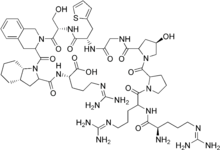Icatibant
 | |
| Systematic (IUPAC) name | |
|---|---|
|
(2S)-2-[[(3aS,7aS)-1-[2-[(2S)-2-[[(2S)- 2-[[2-[[(4R)-1-[1-[2-[[(2R)-2-amino-5-(diaminomethylideneamino) pentanoyl]amino]-5-(diaminomethylideneamino)pentanoyl]pyrrolidine- 2-carbonyl]-4-hydroxypyrrolidine-2-carbonyl]amino]acetyl]amino]- 3-thiophen-2-ylpropanoyl]amino]-3-hydroxypropanoyl] 3,4-dihydro-1H-isoquinoline-3-carbonyl] 2,3,3a,4,5,6,7,7a-octahydroindole-2-carbonyl]amino]- 5-(diaminomethylideneamino)pentanoic acid | |
| Clinical data | |
| Trade names | Firazyr |
| AHFS/Drugs.com | International Drug Names |
| Licence data | EMA:Link, US FDA:link |
| Pregnancy category |
|
| Legal status |
|
| Routes of administration | subcutaneous |
| Identifiers | |
| CAS Number |
130308-48-4 |
| ATC code | B06AC02 |
| PubChem | CID 71364 |
| IUPHAR/BPS | 667 |
| DrugBank |
DB06196 |
| ChemSpider |
16736634 |
| UNII |
7PG89G35Q7 |
| ChEBI |
CHEBI:68556 |
| ChEMBL |
CHEMBL1743581 |
| Chemical data | |
| Formula | C59H89N19O13S |
| Molar mass | 1304.52 g/mol |
| |
| |
| | |
Icatibant (trade name Firazyr, alternative name Hoe 140, JE 049[1]) is a peptidomimetic drug consisting of ten amino acids, which is a selective and specific antagonist of bradykinin B2 receptors. It has been approved by the European Commission for the symptomatic treatment of acute attacks[2][3] of hereditary angioedema (HAE) in adults with C1-esterase-inhibitor deficiency.
Mechanism of action
Bradykinin is a peptide-based hormone that is formed locally in tissues, very often in response to a trauma. It increases vessel permeability, dilates blood vessels and causes smooth muscle cells to contract. Bradykinin plays an important role as the mediator of pain. Surplus bradykinin is responsible for the typical symptoms of inflammation, such as swelling, redness, overheating and pain. These symptoms are mediated by activation of bradykinin B2 receptors. Icatibant acts as a bradykinin inhibitor by blocking the binding of native bradykinin to the bradykinin B2 receptor.
Regulatory status
Icatibant has received orphan drug status in Australia, EU, Switzerland and US for the treatment of angiotensin-converting-enzyme inhibitor (ACE-1) induced angioedema (HAE).
In the EU, the approval by the European Commission (July 2008) allows Jerini to market Firazyr in the European Union's 27 member states, as well as Switzerland, Lichtenstein and Iceland, making it the first product to be approved in all EU countries for the treatment of HAE.[2] In the US, the drug was granted FDA approval on August 25, 2011.[4]
See also
- Ecallantide, another drug for the treatment of HAE
References
- ↑ "Icatibant: HOE 140, JE 049, JE049.".
- 1 2 "Jerini Receives European Commission Approval for Firazyr (Icatibant) in the Treatment of HAE" (Press release). Jerini AG. 2008-07-15. Retrieved 2008-07-22.
- ↑ "Jerini Receives Positive CHMP Opinion Recommending European Approval for Icatibant in the Treatment of HAE; FDA Issues Not Approvable Letter" (Press release). Jerini AG. 2008-04-24. Retrieved 2008-07-22.
- ↑ "FDA Approves Shire’s FIRAZYR (icatibant injection) for Acute Attacks of Hereditary Angioedema (HAE)" (Press release). Shire. Retrieved 2011-08-28.
| ||||||||||||||||||||||||
| ||||||||||||||||||||||||||||||||||||||||||||||||||||||||||||||||||||||||||||||||||||||||||||||||||||||||||||||||||||||||||||||||||||||||||||||||||||||||||||||||||||||||||||||||||||||||||||||||||||||||||||||||||||||||||||||||||||||||||||||||||||||||||||||||||||||||||||||||||||||||||||||||||||||||||